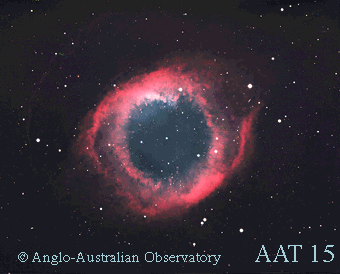
|
Credit & Copyright: Anglo-Australian Telescope
Board
Explanation:
The Helix nebula (New General Catalog number 7293)
is estimated to be a mere 450 light-years from the Sun, in the
direction of the
constellation Aquarius.
At that distance it may well be the closest
planetary nebula,
offering a dramatic snapshot of a brief
final evolutionary stage in the life of a solar-type star.
In this color image the nebula glows red in the light of
nitrogen and hydrogen atoms energized by the
ultraviolet radiation
from the central star.
The main rings themselves, though faint, have an angular
size about half that of the full moon and span about 1.5 light-years.
Because it is so close, it is a prime subject for
study by astronomers. When the Hubble Space Telescope was focused
near the inner edge of the main ring, at about the 12 o'clock position
in the above image,
it resolved some of the spoke like radial structures visible into
intriguing cometary knots.
Information:
The
Scale of the Universe Debate in April 1996
|
January February March April May June July August September October November December |
| ||||||||||||||||||||||||||||||||||||||||||||||||
NASA Web Site Statements, Warnings, and Disclaimers
NASA Official: Jay Norris. Specific rights apply.
A service of: LHEA at NASA / GSFC
& Michigan Tech. U.
Based on Astronomy Picture
Of the Day
Publications with keywords: Helix Nebula - NGC 7293
Publications with words: Helix Nebula - NGC 7293
See also:
